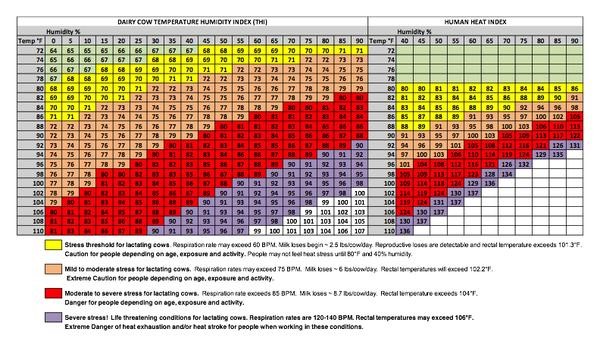Continue to Focus on Heat Abatement
As we continue to move through summer months, it is important to review if we are doing all we can to keep our animals safe during these hotter temperatures. Animals under heat stress decrease in dry matter intake, milk production, conception rate, and can calve earlier.
Pregnant dams under heat stress have recently been observed to deliver heifers that are less productive over their lifetime and have compromised immunity from the start. One chart that should always be followed is the Temperature Humidity Index (THI; show below). Once animals enter a THI above 68, the stress threshold has been reached and heat abatement needs to be implemented, including ventilation and sprinklers. Keep in mind humans enter this stress level at THI of 80.

From University of Minnesota Extension,
A good set-point for fans to turn on is 65 °F. If sprinklers are used, remember it is a combination of wetting the animals and moving air across to increase evaporative cooling. Consider turning on sprinklers at 70 °F, 2 minutes on, every 15 minutes. Using a low-pressure system is best to have larger water droplets. If the barn is over 90, running sprinklers for 5 minutes will be more advantageous. Also, look to cleaning and scrubbing all waterers on a biweekly basis. Bacteria grows more efficiently in warmer conditions, especially if there is excess saliva and feed present in the waterers.
A holding pen is one of the common areas where heat stress can occur, so ensuring all fans are working properly and bringing in fresh air is key. As we get further into summer months, temperatures may stay higher overnight creating less opportunity for animals to cool themselves. This is where recognizing our temperature switches and set points are critical. If cows are on pasture, maintaining 45 – 50 square feet per cow is optimal.
Remember that calves can become heat stressed as well and it is best to do any management work, e.g. dehorning, vaccinating, cleaning, etc. in the morning before the heat of the day. It is important to recognize if calves are dehydrated and use electrolytes if necessary.
On the adult nutrition end, increasing buffer to improve rumen pH and buffering is always crucial. If your feed is heating up, consider using a TMR stabilizer and acid to stabilize the feed in the bunk. Keeping track of nutrition stability in combination with cow management strategies will maximize efficiency and cow well-being during these hot days. Contact your UC Nutrition Specialist or Calf and Heifer Specialist to help evaluate your heat abatement program and how we can improve your operation.